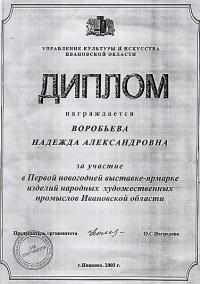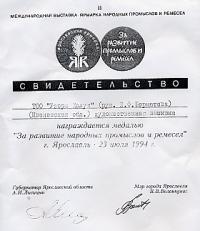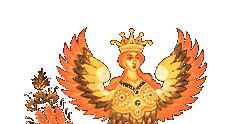 At the beginning of the 18th century Kholuy started developing the icon painting trade within the village. In the tradition of the Kholuy seamstresses, needlework on white linens was also developed along side icon painting. In the 18th century Russia, needlework on very thin cloth, "in net," thread became very popular in the needlework field. "Tambur" was another name given to this seam. It was this style of needlework that Kholuy embroiderers were engaging in during the early stages of the art's development. These "tambur" patterns had added to them small embroidered nets called "stygami." They sewed the thread on the thin cloth in a particular pattern, of which they could make many different nets, which brought to life the white design on the white cloth. There existed another style of "tambur" embroidery, which involved cut-out designs. Embroidery called "pereviti" appeared that had cut-out cloth, which was fashioned along certain threads to subsequently remove imperfections and achieve a soft and tight net. Their products were produced with the help of very thin cloth, some of which had "markizet," "batist," original Kholuy patterns, and designs resembling snowflakes on them.
Before the 1917 revolution it was rare to find a home in Kholuy or the neighboring villages where the woman of the house wasn't feeding her family on what she made from the needlework trade. Until the 20th century large open air markets were held on the River Teza, which flows through Kholuy, where these women sold their cloth wares.
In 1920 the Kholuy labor artel was founded, which had 100 employees, all of whom once free-lanced, and were lead by Seraphima Dmitriyevna Grebehkina. The first artel went under in 2 years and in 1922 most of the women went to the school of needlework to teach and get paid a better wage.
Later in 1922 the artel was reopened, but this time with only 18 employees. This artel was supervised by the Vladimir region's "Artsoyuz." When the county started expanding the artel was put under the supervision of the Ivanovo "Voznesenskiy Gubpromsoyuz." On February 9th of 1928 the artel was accepted into the legal foundation of that "soyuz," or union.
From 1929-1935 the artel's business really boomed. There were slightly more than 500 workers coming from and working in various villages in the county.
At the outset of WWII, from 1941-1945, the normal production was halted and the artel was working on sewing and supplying the army with special orders. Even women beyond the age of 70 were engaging in needlework for the factory. Great masters of needlework were present before and after WWII: O.E. Glebova, E.E. Puretskaya, F.P. Kiryahova, S.F. Nekrasova, M.F. Sivkova, L.F. Bormotova, and N.M. Stepanova to name a few. Bormotova, Stepanova, and A.T. Bushuyeva produced original designs and were considered top level masters. In September of 1941 the artel was handed over to the Yuzha sewing factory-artel, but only 2 years later it was once again working independently.
At the same time the artel was putting out things for everyday use, it was engaged in making special items to display at national and international exhibitions.
In April 1948 the Pavillion of the best original folk crafts in VDNH, Moscow, the artel was awarded a prestigious 2nd level diploma.
Until 1952 the artel put out its product with small tags indicating where it was made, but afterwards they started sewing this directly onto their works. In 1957 this became easier when they started using sewing machines for the first time.
In October of 1960 the artel was reorganized by the government and renamed the Kholuy Needlepoint Factory with a 2nd Level Diploma.
In 1986 the factory moved into a new, two story, brick building and got brand new equipment.
At the beginning of the 18th century Kholuy started developing the icon painting trade within the village. In the tradition of the Kholuy seamstresses, needlework on white linens was also developed along side icon painting. In the 18th century Russia, needlework on very thin cloth, "in net," thread became very popular in the needlework field. "Tambur" was another name given to this seam. It was this style of needlework that Kholuy embroiderers were engaging in during the early stages of the art's development. These "tambur" patterns had added to them small embroidered nets called "stygami." They sewed the thread on the thin cloth in a particular pattern, of which they could make many different nets, which brought to life the white design on the white cloth. There existed another style of "tambur" embroidery, which involved cut-out designs. Embroidery called "pereviti" appeared that had cut-out cloth, which was fashioned along certain threads to subsequently remove imperfections and achieve a soft and tight net. Their products were produced with the help of very thin cloth, some of which had "markizet," "batist," original Kholuy patterns, and designs resembling snowflakes on them.
Before the 1917 revolution it was rare to find a home in Kholuy or the neighboring villages where the woman of the house wasn't feeding her family on what she made from the needlework trade. Until the 20th century large open air markets were held on the River Teza, which flows through Kholuy, where these women sold their cloth wares.
In 1920 the Kholuy labor artel was founded, which had 100 employees, all of whom once free-lanced, and were lead by Seraphima Dmitriyevna Grebehkina. The first artel went under in 2 years and in 1922 most of the women went to the school of needlework to teach and get paid a better wage.
Later in 1922 the artel was reopened, but this time with only 18 employees. This artel was supervised by the Vladimir region's "Artsoyuz." When the county started expanding the artel was put under the supervision of the Ivanovo "Voznesenskiy Gubpromsoyuz." On February 9th of 1928 the artel was accepted into the legal foundation of that "soyuz," or union.
From 1929-1935 the artel's business really boomed. There were slightly more than 500 workers coming from and working in various villages in the county.
At the outset of WWII, from 1941-1945, the normal production was halted and the artel was working on sewing and supplying the army with special orders. Even women beyond the age of 70 were engaging in needlework for the factory. Great masters of needlework were present before and after WWII: O.E. Glebova, E.E. Puretskaya, F.P. Kiryahova, S.F. Nekrasova, M.F. Sivkova, L.F. Bormotova, and N.M. Stepanova to name a few. Bormotova, Stepanova, and A.T. Bushuyeva produced original designs and were considered top level masters. In September of 1941 the artel was handed over to the Yuzha sewing factory-artel, but only 2 years later it was once again working independently.
At the same time the artel was putting out things for everyday use, it was engaged in making special items to display at national and international exhibitions.
In April 1948 the Pavillion of the best original folk crafts in VDNH, Moscow, the artel was awarded a prestigious 2nd level diploma.
Until 1952 the artel put out its product with small tags indicating where it was made, but afterwards they started sewing this directly onto their works. In 1957 this became easier when they started using sewing machines for the first time.
In October of 1960 the artel was reorganized by the government and renamed the Kholuy Needlepoint Factory with a 2nd Level Diploma.
In 1986 the factory moved into a new, two story, brick building and got brand new equipment.
 In 1992 they reregistered to be filed as a small governmental business, with about t 130 workers.
In 1988 the factory is stable, profiting, and filling all of its orders on time. It is also growing by 8-10 percent a year. Women's blouses also became a specialty of the factory, which accounted for 70% of their inventory. Women's nightwear, souvenir napkins, and in small quantities the factory was putting out children's clothing, which included dresses, suits, and clothing for newborns. The turnover of the inventory was at 100% for the clothing and 99% for the needlework and embroidered items.
The factory has been active in many international exhibitions, which has produced many international buyers. In 1992 is was one of the founders of the Joint Stock "Torgoviy Dom narodniye promisli Rossii."
It is worth noting that Kholuy's school of needlework and its status with the government will keep it open and fully operational for many years to come.
In 1992 they reregistered to be filed as a small governmental business, with about t 130 workers.
In 1988 the factory is stable, profiting, and filling all of its orders on time. It is also growing by 8-10 percent a year. Women's blouses also became a specialty of the factory, which accounted for 70% of their inventory. Women's nightwear, souvenir napkins, and in small quantities the factory was putting out children's clothing, which included dresses, suits, and clothing for newborns. The turnover of the inventory was at 100% for the clothing and 99% for the needlework and embroidered items.
The factory has been active in many international exhibitions, which has produced many international buyers. In 1992 is was one of the founders of the Joint Stock "Torgoviy Dom narodniye promisli Rossii."
It is worth noting that Kholuy's school of needlework and its status with the government will keep it open and fully operational for many years to come.
|



